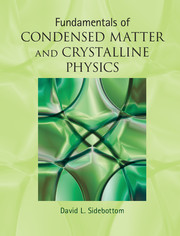 Fundamentals of Condensed Matter and Crystalline Physics
Fundamentals of Condensed Matter and Crystalline Physics 3 - Bonds and cohesion
from Part I - Structure
Published online by Cambridge University Press: 05 August 2012
Summary
Introduction
What makes condensed matter “condensed”? The answer is stickiness (i.e. an attractive interaction) that exists between the particles that make up a liquid or solid. In the last two chapters we have looked at two extremes of particle arrangements in matter: ordered (crystalline) and disordered (amorphous). In this chapter, we now examine the nature of the forces that form between particles and which promote the formation of a condensed phase of matter. We begin by reviewing the five major bonds (van der Waals, covalent, ionic, metallic and hydrogen bonds) and conclude by considering the overall cohesive energy in a crystal. As thermodynamics generally favors the system with lowest energy, this cohesive energy is part of what determines why a particular crystal structure is adopted in Nature, rather than another structure.
Survey of bond types
In order for matter to condense, there must be an attractive force between the particles to promote their mutual gathering together. Of the four fundamental forces in Nature, the two nuclear forces (strong and weak) play no role in the condensation process and the gravitational force is far too weak to drive the process at ordinary terrestrial temperatures and pressures. Instead, the fundamental force that binds particles together in condensed matter arises from electrostatic interactions.
- Type
- Chapter
- Information
- Fundamentals of Condensed Matter and Crystalline PhysicsAn Introduction for Students of Physics and Materials Science, pp. 35 - 49Publisher: Cambridge University PressPrint publication year: 2012
